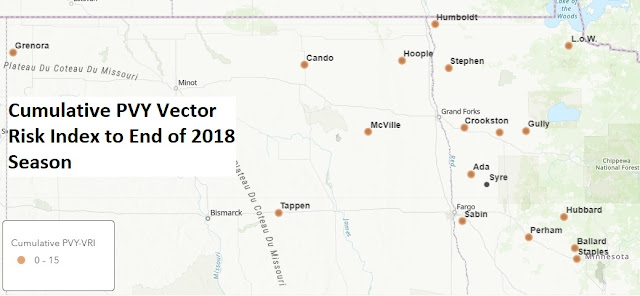Trap Catches Identified to July 19
Greetings!
Trap catches for the week of July 12-19 have increased but are still relatively low. We now have 12 traps reporting and several more will com online next week. No Green Peach Aphid to this point but we recovered 2 Damson-Hop aphids and 1 Cannabis aphid. These populations are lower than last year but we're still including them in our Risk Index calculations. Soybean aphids remain low but are starting to show in a couple of traps. Most of the other aphids recovered in traps this week were the usual suspects for this time of year, including Cotton/Melon, Black Bean, and Thistle aphids. Small grain development is advancing and aphid populations in cereals have been noted in a number of locations. So we can soon expect to start recovering cereal aphids in the traps (and because the 3 most frequent cereal aphid species in MN & ND are PVY vectors, we'll be watching!)
While numbers are still low to this point, aphids are flying and, if you haven't started scouting, it's time to start. The absence of aphids on potatoes, however doesn't mean there's no risk of PVY. Non-colonizing aphid vectors can be as important in sp[reading PVY, if not more so, than many of the colonizing species. Remember, the application of oil is recommended as a mechanism of reducing the spread of PVY.
Aphid Fact of the Week - Aphid reproduction in the summer is parthenogenetic, unfertilized females giving rise to female offspring. In fact, in the aphid species we monitor, there are no males during the summer. Adult females give birth to live daughters, which, sometimes in as short a period as several days, will be giving birth to their own daughters. This system can result in very rapid development of aphid colonies.
As always, keep on scouting!
Cumulative PVY Vector Risk Index to July 19, 2019
Cumulative PVY Vector Risk Index for the 2018 Season (for comparison)
Aphid Species Capture and PVY Vector Risk Index for July 12-19, 2019
Cumulative Aphid Species Capture & PVY Vector Risk - To July 19, 2019.







